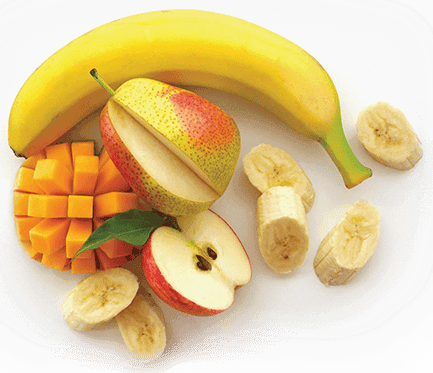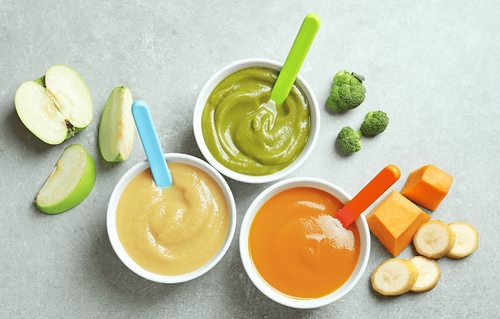This is an automatically translated article.
Green vegetables and fruits contain many vitamins and minerals, have high nutritional value for the development of the baby. Right from the time of weaning, parents should choose for their baby a fruit-based weaning menu as well as a vegetable weaning menu to make their baby's meals more nutritious, richer and more attractive.
1. Why should you add vegetables and fruits to your baby's weaning menu?
In vegetables and fruits contain a lot of fiber, the micronutrients necessary for the development of the baby. In particular, during the baby's weaning period, the addition of a fruit and vegetable weaning menu will help the baby's digestive system work better.
Fiber is a substance that the body cannot digest but has many benefits for the development of the body. Fiber helps intestinal bacteria (a system of beneficial microorganisms in the digestive tract) to grow. From there, the baby's digestive system will work more efficiently, digest food and absorb nutrients better. A meal without fiber makes the baby prone to constipation, leading to many consequences later on such as anorexia, fatigue, growth retardation...
Moreover, vegetables and fruits contain trace amounts of micronutrients. very high nutrients such as protein, vitamins and minerals such as calcium, iron, zinc ... make important contributions to the development of organ systems in the body. Especially vitamins A, B, C from green vegetables and fruits will help strengthen the resistance, limit the risk of allergies for the baby and infectious diseases; Helps the body eliminate toxins and helps the baby absorb iron better. In addition to vegetables, most other foods contain inadequate and very few micronutrients. Therefore, no matter how much a child eats but lacks vegetables and fruits, he will still have rickets, short stature and malnutrition.
Therefore, the fruit-based weaning menu and the vegetable-based weaning menu for babies not only make the baby's meals more attractive and rich, but also provide a full range of vitamins and minerals necessary for the growth and development of children. baby's development.

Thực đơn ăn dặm rau củ quả sẽ giúp hệ tiêu hóa của bé làm việc tốt hơn
2. Fruit and vegetable weaning menu for babies in each stage
The menu of vegetables and fruits for babies is selected according to different age stages. When the baby is just starting the weaning diet, the addition of vegetables and fruits has a lot of things to pay attention to.
According to nutrition experts, fiber needs for babies are calculated according to the formula by 5g + age of the baby. Accordingly, when babies start weaning, they need to provide about 6g of fiber in vegetables and fruits. Parents should introduce fruits and vegetables to their babies when they are about 7 to 8 months old.
Stage 1: When the baby is about 7-8 months old.
This is the time when your baby gets used to the taste of different fruits and vegetables. Mothers can use a combination of 2 or 3 types of vegetables for 1 hour of feeding for their baby or give them to eat with other powdered foods. At this stage, your baby is still eating liquid food, so puree vegetables such as potatoes, pumpkin, broccoli, carrots, ... to create nutritious steamed dishes. guide.
Stage 2: When the baby switches from a liquid diet to a solid food
The baby's nutritional intake will gradually increase over the years and therefore need to increase the number of vegetables and fruits. During this time, the amount of water in the feed should gradually decrease and gradually increase the consistency of the food. Vegetables and fruits can be cut into small pieces and then stewed so that your baby can easily eat them without having to puree them. The new and unique way of processing will add more appeal to the dishes. Besides, parents can add fruit juices to the children's dessert menu.
Stage 3: Baby from 1 year old and above
Baby from 1 year old will start to enter the stage of self-feeding without needing to be fed. Each meal should combine meats, fish, shrimp with vegetables. Vegetables should choose a variety of colors, cut into pieces to eat so that the baby can both hold and eat. Mothers should accompany the baby and encourage him during meals, avoiding bad situations in eating such as choking, choking, etc., causing children to become obsessed with eating and drinking. Vegetables combined with fresh fruits are a great choice that children love.
3. How to choose and process vegetables, tubers and fruits to add to the baby's weaning menu
Each micronutrient in vegetables and fruits plays an important role in your baby's development and immune system. Although the amount of vitamins in green vegetables is very rich, they are also easily lost and can even be changed into harmful substances if they are not properly prepared and cooked. Therefore, in order to ensure the most complete nutritional composition as well as get really nutritious and safe dishes in the weaning menu from vegetables for babies, in the process of choosing, preliminarily preparing and processing vegetables. There are a few important notes below.
When choosing fruit, always pay attention to the baby's health condition: if your baby has digestive disorders or constipation, you should choose fruits with high fiber and cold properties such as bananas, apples, pears. .. Limit the use of thermogenic (hot-tempered) fruits such as pineapple, green mango, durian, longan, lychee, rambutan, ... because it makes the baby prone to allergies or bloating, gas, difficulty pepper. Ensure food safety and hygiene: should choose foods from reputable sources, with full labels, clearly recorded ingredient information and appropriate food distribution according to the baby's menu. Buy enough vegetables and fruits to eat during the day; Do not store vegetables, tubers and fruits for too long in the refrigerator because the food is no longer fresh, the decomposition process is likely to cause food poisoning. The best time to use green vegetables is within 24-48 hours after purchasing. Wash fruits and vegetables thoroughly to remove dirt and soak with vegetable washing solution or diluted salt water to ensure safety. But do not soak for too long, as vitamins B and C will be dissolved in water. The reasonable time to soak is about 15 - 30 minutes. It is better to choose to process vegetables by steaming, rather than boiling, because this will help retain more nutritional components in vegetables, limiting the loss of many vitamins due to being dissolved in water. If boiled, you should let the vegetables drain before you put them in boiling water, just boil the vegetables until they are soft, enough to mash, easy to eat, not too soft, it will lose nutrients as well as make the vegetables taste better. hard to eat. When babies are just learning to eat solid foods, within the first 1-2 weeks, they should use fine powdered tubers and fruits to help them gradually get used to the taste of food. Then, the mother can combine a green vegetable with a tuber or fruit to make a baby powder. Spinach, jute, cabbage, broccoli and other vegetables are the most suitable choices because they are both nutritious and easy to eat, which will help your baby eat better. When choosing vegetables, take only the young leaves, light green or bright green, without too much fiber for easy mashing. After being boiled, vegetables and fruits are cut into pieces, making them a simple but attractive snack for children to hold food and chew on their own. Usually, children do not like to eat green vegetables because the color is not as fresh as the tubers and fruits. Therefore, just combining foods with many eye-catching colors and funny decorations will help children excitedly enjoy and eat better.

Nếu bé bị táo bón, nên chọn các loại trái cây có nhiều chất xơ, tính hàn như chuối, táo, lê
4. Some suggestions for weaning dishes from vegetables, tubers and fruits
Here are some suggestions for weaning menus from vegetables for babies.
Baby powder with pureed papaya and pear Powder with pureed potatoes, carrots and corn Mashed banana: a banana contains 105 calories and rich vitamin B6 and potassium content for babies to eat well and sleep well. . Bananas also provide fiber to help with good digestion and prevent constipation. Eating solids with mashed banana will give your baby an ideal meal because it is both rich in energy and full of nutrients. Mashed avocado: avocado contains many beneficial fats and is rich in omega 3 which is good for the physical and intellectual development of the baby. Like bananas, the snack from mashed avocado with milk will be a great suggestion to add to the baby's fruit-based weaning menu. Mashed carrots: carrots are rich in vitamin A, beta-carotene, have an eye-catching color and delicious taste, and can be stored for a long time in the refrigerator. Mashed carrots is an indispensable snack for babies. Pumpkin mashed: Pumpkin not only has beautiful and attractive colors, but also contains a lot of starch, high levels of vitamin A, vitamin C... so it is very good for the development of babies. In addition, most children love to eat pumpkin because when cooked, pumpkin has a natural sweetness and is easy to eat. Therefore, mashed pumpkin is a dish that is always mentioned in the weaning menus from vegetables for babies. Broccoli: with a rich source of nutrients including fiber, vitamins, and calcium, the taste is also very suitable for the taste of young children, broccoli is considered one of the foods of choice. for the holistic development of the child. The rich amount of fiber and vitamin C in broccoli helps your baby to absorb nutrients easily, gives your baby a healthy digestive system and makes an important contribution to strengthening the immune system. In addition, broccoli is also known for its effective anti-cancer role. In addition to the nutritional diet, parents should supplement their children with supporting products containing lysine, essential micro-minerals and vitamins such as zinc, chromium, selenium, and B vitamins to help fully meet their nutritional needs. in children. At the same time, these essential vitamins also support digestion, enhance nutrient absorption, help improve anorexia, help children eat well, and develop comprehensively.
Please regularly visit Vinmec.com website and update useful information to take care of your baby and family.













